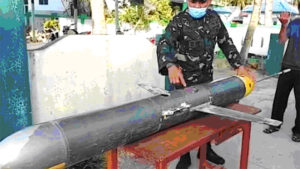Indonesian Fisherman Caught What Appears To Be A Chinese Underwater Drone
29 December 2020
The craft matches an underwater glider that China builds, which is capable of traveling for weeks and over huge distances.
A fisherman in Indonesia, referred to only as Saeruddin, recently brought in a very different kind of haul, catching what appears to be a Chinese underwater drone. At least two other very similar, if not identical ocean glider-type unmanned undersea vehicles have been found in Indonesian waters in the past two years. This raises questions about whether the Chinese government is discreetly conducting underwater surveys of routes between the South China Sea and the Indian Ocean, information that could be especially useful for its submarines transiting through these areas while submerged.
Saeruddin reportedly nabbed the drone on Dec. 20, 2020, near the Selayar Islands, an archipelago that is part of Indonesia’s South Sulawesi province, in the central part of the sprawling nation, which consists of more than 17,000 individual islands. He subsequently handed it over to local police, who then turned it over to the Indonesian military.

A glider-type unmanned undersea vehicle recovered off the coast of Indonesia’s Selayar Islands in December 2020.
A report from Indonesian outlet detikNews said that the drone, which had what appeared to be some kind of sensor array in its nose, was just under 7.4 feet long, not counting what appears to be a long antenna or sensor extending from the rear end. Pictures of the unmanned undersea vehicle (UUV) show that it has a torpedo-shaped body with a pair of wings mounted toward the center and a vertical tail.
Twitter user @Jatosint was among the first to note the strong similarities to the Sea Wing UUV, a design developed and produced by the state-run Chinese Academy of Sciences’ (CAS) Shenyang Institute of Automation and that has been in use since at least 2014. An ocean glider-type underwater drone, Sea Wing moves forward in the water, aided by its wings and tail, by repeatedly diving and then surfacing again. It performs these maneuvers using an internal system, essentially a balloon that expands and contracts as pressurized oil moves in and out, which alters its buoyancy.
Courtesy: The War Zone

